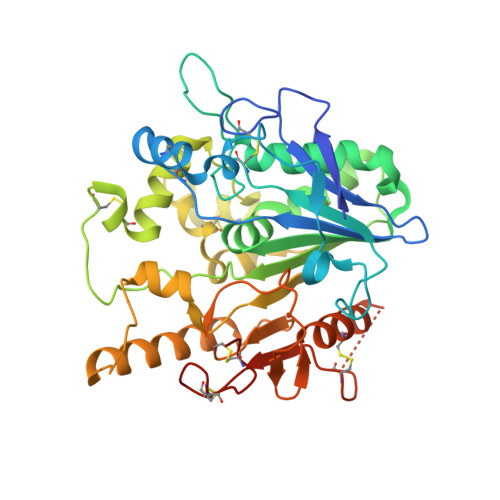5-Phenyl-1,3,4-oxadiazol-2(3 H )-ones Are Potent Inhibitors of Notum Carboxylesterase Activity Identified by the Optimization of a Crystallographic Fragment Screening Hit.
Mahy, W., Willis, N.J., Zhao, Y., Woodward, H.L., Svensson, F., Sipthorp, J., Vecchia, L., Ruza, R.R., Hillier, J., Kjaer, S., Frew, S., Monaghan, A., Bictash, M., Salinas, P.C., Whiting, P., Vincent, J.P., Jones, E.Y., Fish, P.V.(2020) J Med Chem 63: 12942-12956
- PubMed: 33124429
- DOI: https://doi.org/10.1021/acs.jmedchem.0c01391
- Primary Citation of Related Structures:
6ZUV, 6ZVL - PubMed Abstract:
Carboxylesterase Notum is a negative regulator of the Wnt signaling pathway. There is an emerging understanding of the role Notum plays in disease, supporting the need to discover new small-molecule inhibitors. A crystallographic X-ray fragment screen was performed, which identified fragment hit 1,2,3-triazole 7 as an attractive starting point for a structure-based drug design hit-to-lead program. Optimization of 7 identified oxadiazol-2-one 23dd as a preferred example with properties consistent with drug-like chemical space. Screening 23dd in a cell-based TCF/LEF reporter gene assay restored the activation of Wnt signaling in the presence of Notum. Mouse pharmacokinetic studies with oral administration of 23dd demonstrated good plasma exposure and partial blood-brain barrier penetration. Significant progress was made in developing fragment hit 7 into lead 23dd (>600-fold increase in activity), making it suitable as a new chemical tool for exploring the role of Notum-mediated regulation of Wnt signaling.
Organizational Affiliation:
Alzheimer's Research UK UCL Drug Discovery Institute, University College London, Cruciform Building, Gower Street, London WC1E 6BT, U.K.


















